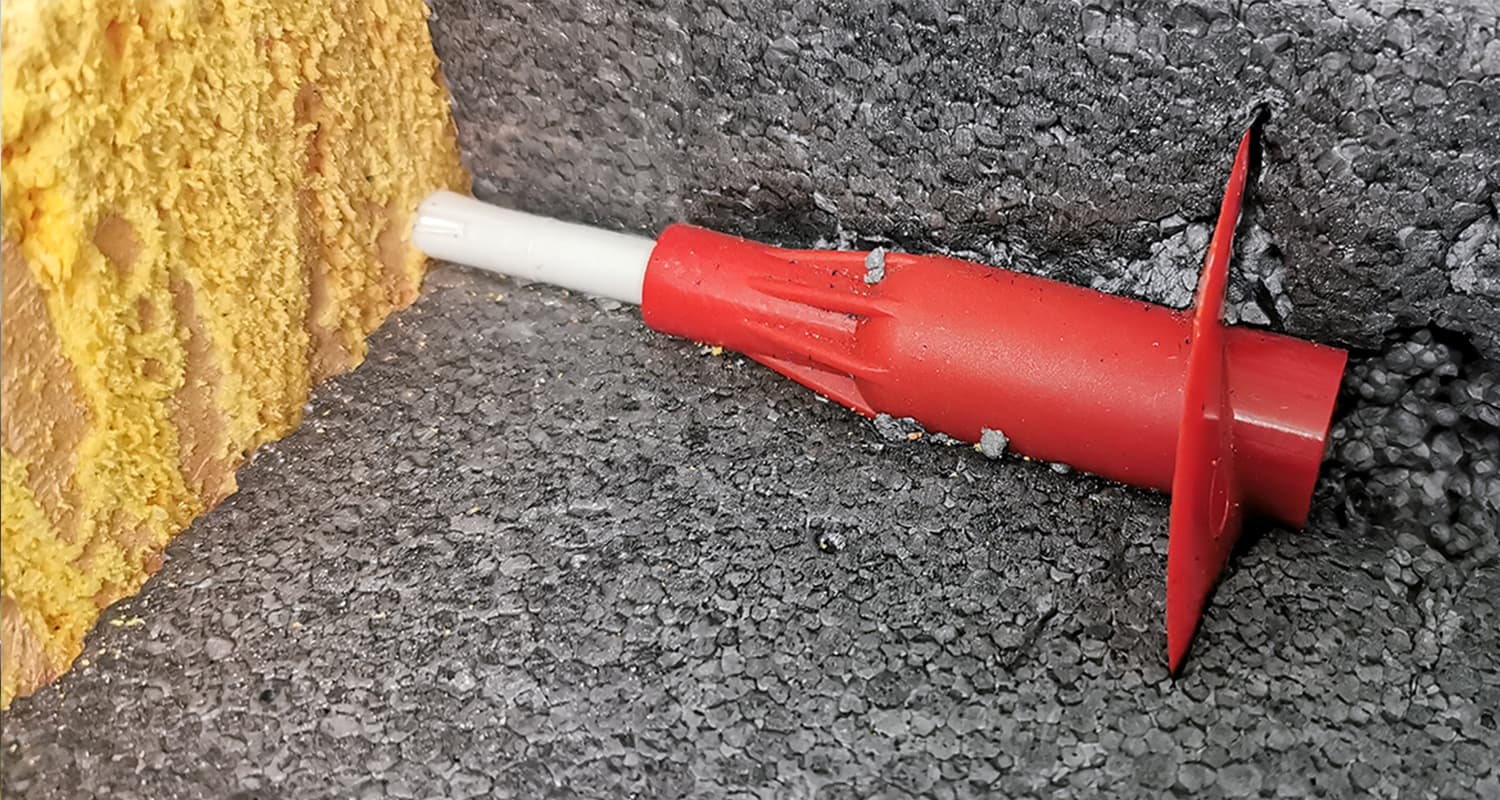Before fastening an external thermal insulation composite system on a façade, you need to factor in a few things. In new buildings, often a fully adhesive system is used while for renovations you can choose from as many as three different fastening systems in Germany. The anchor may be only a small part in these systems, but its significance is huge.
The type of fastening solution required for an external thermal insulation composite system (ETICS) depends largely on the system components and the façade surface’s condition. On the one hand, insulation board type and board thickness make up a large part of the system weight. Mineral wool, for example, is significantly heavier than expanded polystyrene (EPS), which becomes highly apparent especially when using insulation boards with higher thicknesses. In addition to weight, wall surface coating, substrate load-bearing capacity and wall surface evenness are decisive factors.
For the fastening of an ETICS that has National Technical Approval several methods are allowed:
- Fully adhesive systems up to max. 1 cm/m adhesive layer
- Adhesive systems with additional mechanical fastening (anchoring) up to max. 2 cm/m adhesive layer
- Mechanical rail systems using dots of adhesive up to max. 3 cm/m wall surface unevenness
- Fully mechanical fastening without an adhesive using the Stellfuchs fastening system up to max. 7 cm/m wall surface unevenness
External influences have a great impact
An ETIC system’s own weight varies from insulation board type and thickness between 10 and 50 kg per m2. Wind pressure and wind suction are highly region-specific. The regional wind loads are divided into various country-specific wind zones. The maximum permissible wind suction for ETIC systems must not exceed we = 2.2 kN/m2. Beyond that, hygrothermal behaviour, i.e. seasonal humidity and temperature fluctuations, will affect the ETIC system permanently.
Once these loads are taken care of, an ETICS can absorb statical and structural loads in the long term over a usage period of up to 40 years. The stability of an external thermal insulation composite system must be ensured lastingly. If not, structural damage will occur: Insulation boards may start to display anchor marks or, in the worst case, come off.
Gluing requirements for new and old buildings
Dusty, dirty or sucking substrates require a pre-treatment for all adhesive systems. Peeling paint and a damp substrate are not suitable to be glued. Loose elements must always be removed and cavities in the old render chipped off. Essential procedures for checking the condition of a wall surface include a wipe test to check whether a surface is free of dust, checking for harmful efflorescence or chalking old coatings in addition to a scrape and scratch test, tapping test, and a wetting test.
With an adhesion test you can check the tear resistance of an adhesive towards a substrate. This test will indicate whether a wall surface is load-bearing or suitable for gluing. Only if the value exceeds 0.08 N/mm2 (80 kPa) an additional anchoring procedure is not required. Such tests, however, are time-consuming and expensive, which is why, from an economical point of view, they can be carried out only through spot checks. In order to assess the condition of a wall surface adequately, at least every side of the building should be checked on several floors.

When to use ETICS anchors for adhesive systems
Think of the ETICS anchor as a kind of emergency parachute for adhesive systems while the adhesive as the parachute is responsible for carrying the ETIC system. If system and building substance behave as calculated, all is fine. If, however, in the course of time radical changes occur in the substrate, you must pull the emergency parachute. Where the adhesive fails, the anchor steps in. Together with the ETIC system’s own weight it will press the insulation material against the raw wall surface, preventing the system from failing.
Changes occur partially due to long-term changes in the wall surface and high wind load. Climate change gives rise to the fear that in future we must expect extreme storm events more often.
Anchoring requirements for new and old buildings
In DACH countries, a new building with standard-compliant brickwork and even substrates, requires no anchoring because the substrate is load-bearing and therefore suitable for gluing. This, however, applies only to even façades and systems with EPS up to a system weight of max. 30 kg/m2 and a maximum adhesive application of 1 cm/m. If this is the case, the tear resistance between adhesive and substrate will meet the necessary minimum requirement of 0.08 N/mm2 or 80 kPa. Render substrate boards that consist of mineral wool, however, require anchoring even in new buildings due to the heavy weight and low transverse tensile strength (3.5 to 10 kPa).
As for old buildings, there are several factors that require anchoring because usually the substrates do not comply with modern standards or have old render. In practice, the tear resistance of the adhesive from the substrate is mostly lower than 0.08 N/mm2 or 80 kPa, or due to economic reasons cannot be verified across the entire structure. Therefore, additional anchoring is generally recommended for renovations.
The number of anchors per m2 results from a professional anchor number calculation which is based on the permissible load class of the anchors, anchor pull-out values on site, and a wind load calculation. (Why it makes sense to have the number of fixings calculated)
The bottom line is: The ETICS anchor is an important system component of glued and dowelled external thermal insulation composite systems in order to ensure an overall functional system in the long term. A professional anchoring makes sure that the insulation system withstands adhesive failure and that the rendered façade weathers storms without any damage. Due to changes in our climate anchors will gain more significance in future.



